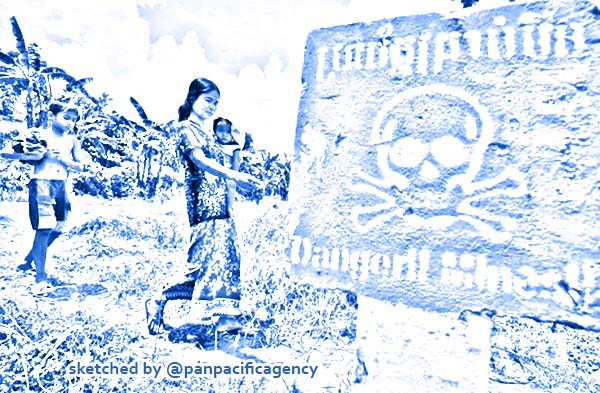Cambodia’s govt steps up to reach 2025 mine-free goal

It is estimated that mines and explosive remnants of war (ERW) are still scattered over an area of 2,149 square km in the country. AFP. Sketched by the Pan Pacific Agency.
PHNOM PENH, Feb 23, 2020, The Phnom Penh Post. Prime Minister Hun Sen has allowed the Cambodian Mine Action and Victim Assistance Authority (CMAA) also known as the Mine Authority to access funds to deploy 2,000 Royal Cambodian Armed Forces (RCAF) personnel in the humanitarian demining operation from 2020-2025, The Phnom Penh Post reported.
Hun Sen’s letter on the 21st anniversary of National Mine Awareness Day, obtained by The Post on Wednesday, said mines, cluster bombs and explosive remnants of war had not only caused citizens to be disabled or lose their lives, but also posed obstacles to rehabilitation, the development of families’ livelihoods and the national economy.
The letter said to enhance demining operations in accordance with the “Mine-Free Cambodia” strategic plan, the government had decided to make a 10 per cent contribution to all new projects for humanitarian demining in a bilateral or multilateral manner.
The government had also set out concrete plans to embark on mine related research in 73 districts in the eastern part of the country this year.
“As the head of the government, I gave permission to the Mine Authority to continue with the participation of 2,000 RCAF [personnel] in the humanitarian demining operation.
“However, from 2020 to 2025, Cambodia still needs a further $377 million to demine some 806sq km of land that contains cluster bombs and explosive remnants of war,” the letter said.
Hun Sen called on citizens who encountered mines, cluster bombs and explosive remnants of war not to touch them.
“They have to report them to the local authorities or the nearest demining operation units. They must not buy, sell, store, or improvise mines, cluster bombs and explosive remnants of war. This is against the law,” he said.
Senior Minister in charge of Special Missions and secretary-general of CMAA Ly Thuch said on Wednesday that he supported Hun Sen’s initiative.
He also urged more participation from other countries, development partners and national and international organisations to speed up demining so that citizens could cultivate crops, and build villages and infrastructure which would, in turn, contribute to poverty reduction.
He said mines, cluster bombs and explosive remnants of war still threatened citizens and posed obstacles to national development.
Last year, the rate of victims had increased by 33 per cent, compared to 2018.
“Though mine-clearing has yielded good results, we still continue to educate and widely promote demining operations through the radio, TV channels, social media, posters and leaflets.
“We will incorporate it into the education curriculum of the Ministry of Education, Youth and Sport as well as apply the law on the management of weapons, explosives and ammunition and take further administrative action,” he said.
Ministry of National Defence spokesperson Chhum Socheat could not be reached for comment on Wednesday.
Cambodian Mine Action Center (CMAC) director-general Heng Ratana said on Wednesday that this recommendation was a positive move to promote the exploration and the demining of land mines in line with development plans.
He said that CMAC had trained more than 300 army officers in crucial skills and awareness around demining, including rules, exploration, safety protection and mine destruction.
“The soldier officers have learnt a lot. It can be said that they are capable of joining us in demining operations. CMAC will continue to further train our soldier forces to meet the necessary needs.
“However, we still lack some of the resources to equip officers with everything they will need in the field,” he said.
Demining activities and the removal of cluster bombs and explosive remnants of war in Cambodia has been ongoing for 28 years from 1992 to 2019.
During this time, some 1,080,814 anti-personnel mines, 25,186 anti-tank mines, and 2,832,626 cluster bombs and explosive remnants of war were found and destroyed. The number of victims had also declined from 4,320 in 1996 to 77 in 2019.